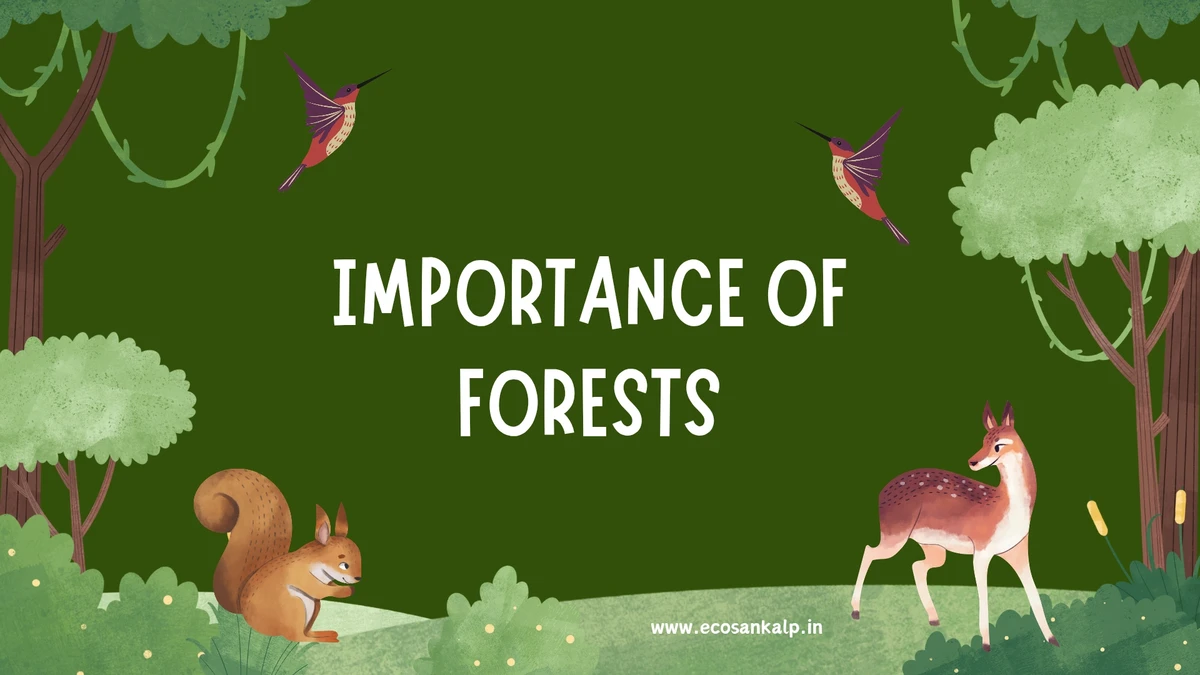10 Importance Of Forest You Need To Know

Amid the convenience and sophistication of modern lives, we forget the importance of forests. Forests are not just a collection of trees, vegetation, and houses of wildlife, they’re invaluable. They contribute to climate regulation, absorb carbon dioxide, release the oxygen we breathe, and bless our planet with a captivating beauty.
Even then it is sad to say that forests are not treated well. Unfortunately, they’re rapidly smashing and chopping down by the people for personal motives. Despite the government’s efforts on forest conservation, massive amounts of trees are cut down illegally.
As we confront of pressing challenges of climate change and environmental degradation, preservation and restoration of forests becomes an alarming call. The rate forests are dwindling can bring a devastating ripple effect on humans, animals, and the planet.
There are countless reasons why forests are incredibly important and protecting them is pivotal.
Page Contents
Understanding Forests and It’s Types Found In India:
A forest is a large expanse of land primarily, covered with trees, other living plants, and wildlife. Forests can vary widely in size, density, and ecological characteristics, namely, Tropical evergreen forests, Tropical deciduous forests, Scrub forests and grassland, Desert vegetation, Mountain forests, Mangrove forests, and more.
They absorb carbon dioxide and release oxygen, provide habitat, food, and medicines, protect our ecosystem, and play a significant role in sustaining lives. They’re also known as the lungs of the Earth.
1. Tropical Rainforest
- Location: Western Ghats, Andaman and Nicobar Islands, parts of Northeast India, and more.
Tropical rainforests or tropical evergreen forests are the most dense forest types located around the equator. Due to their geographical location, these forests get extreme temperatures and substantial rainfall makes them evergreen throughout the year. Tropical rainforests are known for their extremely rich biodiversity as research shows they’re the home of more than half of the plant and animal species found in the whole world.
That includes many rare species of plants, animals, and trees which cannot be found anywhere. The extremely dense population, tallest and thickest trees, and wildlife are extremely pleasure to see. However, Tropical rainforests are rapidly diminishing by human activities such as logging, land expansion for agriculture, and other unsustainable activities.
The Amazon Rainforest, the Congo Rainforest, Australiasian Realm, Sundaland, Indo-Burma,Wallacea, Mesoamerica, Guinean Forests of West Africa, Atlantic Forest, Chocó-Darien, etc., are a few examples of tropical rainforest or evergreen forests.
2. Tropical Deciduous Forests:
- Location: North-eastern states, Eastern Ghats, Madhya Pradesh, Gujarat, Odisha, the foothills of the Himalayas, and more.
Tropical deciduous forests are a type of forests that are common in parts of India, Southeast Asia, Africa, and Central America. In these forests, most of the tree’s leaves are often shed in dry winters and stay green in wet summers. These forests are also known as ‘Monsoon Forests”. Sal, Teak, Neem, Shisha, Peepal, Khair, Bel, Axle wood, Palas, Laurel, etc., are commonly found trees in tropical deciduous forests.
3. Temperate Forests:
The temperate forests are the second largest terrestrial biome covering 25% of the total forest area in the world. They’re located in regions with temperate climates. These forests experience four distinct seasonal changes – spring, summer, autumn, and winter.
- Location: Kashmir, Uttaranchal, Himachal Pradesh Sikkim and Darjeeling
4. Alpine and Subalpine Forests:
- Location: Kashmir to Arunachal Pradesh
The dominant vegetation in this forest consists primarily of coniferous trees, such as spruces and pines. These trees can survive cold climates and withstand heavy snow.
5. Mangrove Forests:
- Location: Sunderbans and Ganges Delta
The Mangrove forests consist of more than 80 different species of mangrove trees that are some of the only coastal trees that thrive in salty water. The intricate root system of the mangrove trees stabilizes shorelines and prevents soil erosion. The complex root system also provides vital habitats and food for marine life. These forests are found in tropical or subtropical regions, characterized by salt-tolerant plants and shrubs that thrive in intertidal zones.
6. Tropical Thron Forests:
- Location: Rajasthan, Gujarat, Madhya Pradesh, Chhattisgarh, Uttar Pradesh, and Haryana.
Tropical Thron Forests are mostly found in arid and semi-arid regions with scrub-like vegetation. These forests experience low rainfall that stick around 70 cm.
7. Montane Forests:
- Location: Found in northern and southern part of India.
Montane forests are found in mountains and eastern and western Himalayas region. They are high-altitude forests that experience decrease in temperature.
10 Importance Of Forests or Reasons To Conserve Them:
The importance of forests is far more than the captivating beauty they provide to the Earth. From contributing to climate regulation to spreading purified air to providing essential resources to sustain lives they provide myriad benefits to the environment and lives. There are countless reasons why we need to stop forest destruction and be more kind to them:
1. Protects Biodiversity
The forests are secure and comfortable homes for various plant, animal, reptile, and bird species. They depend on forests to source food and shelter to survive. If we destroy forests, we indirectly make them homeless and food less. As a result, many of them may not survive and are extinct from the Earth. This is how forest protects many species that are vital for ecological balance or biodiversity.
2. Climate Regulation
Forests have a major role in climate regulation and maintaining a healthy climate scenario. If there is no forest on the Earth, it could have a devastating effect on lives on Earth. Consequently, we may not survive. In short, the forests absorb carbon dioxide and mitigate climate change.
3. Oxygen Production
One of the most important points why we should protect forests is because forests absorb carbon dioxide (toxic gas) and provide life-saving oxygen. Trees and plants produce large amounts of oxygen during the process of photosynthesis. Forests are natural oxygen providers for us.
4. Foods and Medicines
Forests are great hubs for sourcing essential materials that are used to manufacture medicines to fight against various chronic diseases. Additionally, they provide us with several foods such as mushrooms, almonds, walnuts, Brazil nuts, honey, spices, etc.
5. Provide Resources
Forests provide many resources for making many common items like furniture, books (from bamboo trees), doors, desks, cabinets, wooden things, and even lottery tickets are made of using resources comes from forests. Moreover, many families in villages still depend on forest resources for fuel while cooking food in Chulha (a traditional Indian cooking stove).
6. Improve Air Quality
The WHO report says, that every year more than four million people die cause of outdoor air pollution. Forests act as natural air purifiers that absorb harmful chemicals and maintain air quality. This is why we feel a clean and healthy air in forest locations.
7. Maintain Water Cycle
Are you wondering how forests support the water cycle? Transpiration in trees and plants is the reason for that. Transpiration is a process in trees and plants in which they absorb water through their roots and later release it from their leaves. The released water goes up as a vapor and accumulates into clouds until it starts rainfall, snowfall, or hailing.
8. Protect Us From Natural Disasters
The strong roots of trees hold soils or lands that prevent soil erosion and landslides that can destroy millions of lives during heavy rain. Moreover, forests contribute to climate regulations, mitigate extreme weather conditions, and provide a natural defense against various environmental hazards.
9. Purify Water
Forests play an essential role in protecting our natural resources like water from chemical pollutants. Trees and other vegetation keep our rivers, lakes, and ponds healthy by absorbing and filtering out harmful sediments and pollutants from the water.
10. Habitat for Wildlife
Forests are home to a wide range of wildlife species. They provide food to foraging animals and shelter for protection from predators. By preserving forests, we ensure the life of countless species and the health of ecosystem.






